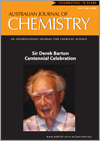
Australian Journal of Chemistry
Volume 71 Number 9 2018
Sir Derek Barton – Centennial Celebration
The foreword to this special issue of the Journal dedicated to Sir Derek Barton provides an account of his distinguished career and his legacy for Australian organic chemistry.
CH18256Recent Advances in Steroid Synthesis: A Tribute to Sir Derek Barton
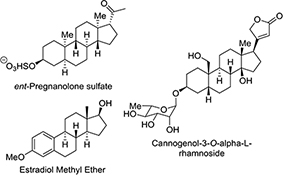
The synthesis of steroids and gaining an ultimate understanding of their reactivity was one of Sir Derek Barton’s most notable research areas. This highlight will focus on the construction of the steroid ring system from 2016 to 2018, and will include some of those that eventually led to natural product synthesis.
CH18220Recent Advances in Photodecarboxylations Involving Phthalimides

This review covers recent advances in photodecarboxylation reactions involving phthalimides. The intramolecular reaction protocol allows for the easy construction of medium- to macrocyclic ring systems. In contrast, photodecarboxylative additions have been developed as versatile alternatives to Grignard-type reactions. Selective photodecarboxylative transformations have been realized in advanced photoreactors.
CH18141Biomimetic Synthesis of Hyperjapones F-I
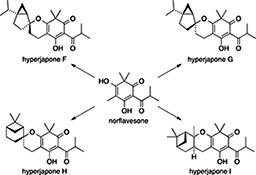
The hyperjapones are a family of complex, polycyclic meroterpenoids that appear to be biosynthesised via cycloadditions between simple terpene natural products and a dearomatised polyketide. This biosynthetic hypothesis is used to inspire divergent, biomimetic syntheses of four hyperjapone natural products.
CH18145Chemoenzymatic Syntheses of Some Analogues of the Tricarbocyclic Core of the Anti-Bacterial Agent Platencin and the Biological Evaluation of Certain of their N-Arylpropionamide Derivatives
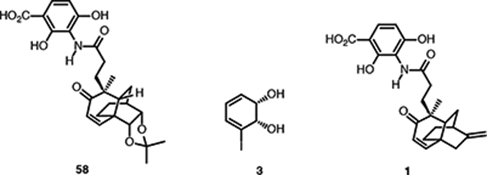
Three analogues, including compound 58, of the potent antibiotic platencin 1 have been prepared by total synthesis from the homochiral starting material 3 and subject to relevant biological evaluations.
CH18191Brønsted Acid-Catalysed Allylic Amination of 1-(2-Aminoaryl)prop-2-en-1-ols to 1,2-Dihydroquinolines
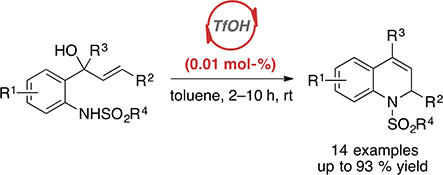
A highly efficient synthetic method to prepare 1,2-dihydroquinolines that relies on TfOH-catalysed allylic amination of 1-(2-aminoaryl)prop-2-en-1-ols is described. Achieved at a catalyst loading of 0.01 mol-% under mild conditions at room temperature, the reaction was found to be robust, with a wide range of substitution patterns tolerated. The corresponding N-heterocyclic adducts were obtained in good to excellent yields of 45–93 %.
CH18197Gold- and Silver-Catalysed Cyclisation Reactions of β-Amino Allenes

We have successfully shown that β-amino allenes can be cyclised by both AgI and AuI catalysts with a divergence in selectivity between the size of the heterocyclic ring formed depending on both catalyst and solvent choice.
CH18196Competitive 1,3-Dipolar Cycloaddition Reactions of an Azomethine Ylide with Aromatic and Carbonyl Groups of Nitro-Substituted Isatoic Anhydrides

An unexpected cycloaddition-dearomatisation process is reported. N-methyl-5-nitroisatoic anhydride underwent cycloaddition to both the isatoic anhydride C1-carbonyl group and to the nitro-substituted aromatic ring. The dearomative cycloaddition reactions result in the formation of novel tetracyclic products and opens up a new area of isatoic anhydride chemistry.
CH18198Are Aminomethyl Thioesters Viable Intermediates in Native Chemical Ligation Type Amide Bond Forming Reactions?

Are aminomethyl thioesters viable intermediates in native chemical ligation type amide bond forming reactions? Our findings suggest that even if such intermediates are formed en route to amides, no advantages are offered over the direct acylation of amines with thioacids.
CH18265Siliquapyranone: A Tannic Acid Tetrahydropyran-2-one Isolated from the Leaves of Carob (Ceratonia siliqua) by Pressurised Hot Water Extraction

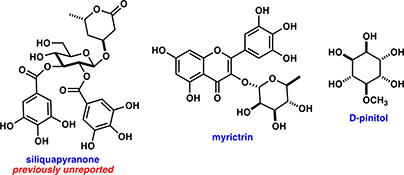
Studies of the phytochemistry of carob (Ceratonia siliqua) leaf material are extremely limited. Seven cultivars of carob leaf material sourced from an Australian commercial crop were extracted and previously unreported tetrahydropyran-2-one siliquapyranone was isolated in addition to known natural products myricitrin, d-pinitol, and sucrose.
CH18194Alkyne-Substituted Fimbrolide Analogues as Novel Bacterial Quorum-Sensing Inhibitors

Owing to the rapid rise in antibiotic resistance, the development of novel antimicrobial compounds with unique mechanisms of action is of utmost importance. In this study, new fimbrolide analogues were synthesised and were found to possess antimicrobial activity targeting quorum sensing, which is important for bacterial communication. These compounds represent promising leads towards the development of a new class of antibacterials.
CH18206Thioamide Derivative of the Potent Antitubercular 2-(Decylsulfonyl)acetamide is Less Active Against Mycobacterium tuberculosis, but a More Potent Antistaphylococcal Agent
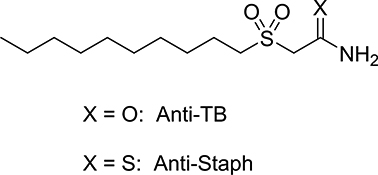
A simple but potent antitubercular compound, 2-(decylsulfonyl)acetamide, loses activity when its amide is converted to a thioamide. However, the latter compound has increased potency against Staphylococcus aureus, but this appears due to a general increase in its toxicity.



